Information in the review is provided as of March 1, 2024
Active combat training in the Belarusian Armed Forces continued in February. The experience of the war in Ukraine was taken into account during its organization.
The level of presence of the Russian Armed Forces didn’t change in February. There may be about 2000 Russian military in Belarus. The activity of units of the Russian Armed Forces stationed in Belarus remains very low.
There are reasons to believe that some of the PMC Wagner mercenaries may have left Belarus. So far, we can’t speak about the complete shutdown of their activities in Belarus.
The general medium-term forecast of the military situation in Belarus remains the same. There is no reason to expect an offensive by the Russian Armed Forces from the territory of Belarus, as well as an increase in their military presence. Involvement of the Belarusian Armed Forces in combat operations against Ukraine is still unlikely. The significance of PMC Wagner as a destabilizing factor continues to decrease.
Throughout February, field drills were reported in the 56th and 115th Anti-Aircraft Missile Regiments, the 557th Engineering Brigade, and the 310th Artillery Group.
Important combat training activities include the following:
1) From January 31 to February 6, a readiness inspection of the on-duty forces was conducted in the Northwestern Operational Command. During the inspection, soldiers practiced the organization of interaction between reconnaissance, UAV and artillery units. The final stage of the inspection was the control firing with small arms, infantry fighting vehicles and artillery systems.
2) In February, one of the companies of the 202nd Separate Mechanized Battalion of the 6th Mechanized Brigade, as well as a motorized rifle unit of the 11th Mechanized Brigade, trained at the ‘resistance hub of the Kobryn fortified area’ located in the vicinity of Saki village, Zhabinka district. The units practiced active defense.
3) On February 8, a combat readiness inspection was conducted in the Air Force and Air Defense Forces of the Belarusian Armed Forces. The inspection involved Anti-Aircraft Missile and Radio-Technical troops, as well as aviation.
4) A joint staff training was held in the Western Operational Command. During the training, they worked out issues related to the conduct of combat operations in defense.
5) On February 14, Belarusian servicemen trained at the 333rd combat training center of the Russian Armed Forces returned to Belarus. The training focused on the experience gained by the Russian Armed Forces during the war in Ukraine. In the future, the servicemen will train the Belarusian Armed Forces as instructors. The practice of training instructors for the Belarusian Armed Forces will continue in Russia.
6) On February 28-29, the transfer from peacetime to wartime was practiced at the Minsk military commandant’s office.
At combat trainings, units practiced combat in urban environments and trenches. A lot of attention was paid to practicing combat against UAVs, as well as training of UAV operators.
Announcement of drills.
1) On February 14, a briefing was held at the CSTO Crisis Response Center by Andrei Serdyukov, Chief of the CSTO Joint Staff. It was reported that in 2024, no major CSTO drills would be held on the territory of Belarus.
2) On February 22, it became known that in 2025, drills of the “regional group of troops” of Belarus and Russia would be held on the territory of Belarus. Since 2009, strategic drills “West” or operational drills “Union Shield” have been held every two years on the territory of both countries. Eight such drills have been held from 2009 to 2022.
Training of Belarusian enforcers by PMC Wagner mercenaries.
Throughout February, training of servicemen by PMC Wagner mercenaries was conducted. As before, more active trainings were conducted with special forces units of the Internal Troops. It was reported that a training on storming trenches and cleanup of buildings was conducted. On February 9, it was announced about the completion of the sixth training course for servicemen of the Internal Troops by mercenaries of PMC Wagner. Internal Troops Commander Mikalai Karpiankou said that “this was not the last training” and that they “will start a new special course on combat coordination of special forces units.” In total, from July 2023 to February 2024, more than 1600 people underwent training with PMC Wagner mercenaries.
Also, trainings with the 78th Separate Mechanized Battalion of the 6th Mechanized Brigade under the guidance of PMC Wagner mercenaries continued at the Obuz-Liasnouski training ground. The servicemen were trained in firing grenade launchers and Konkurs anti-tank missile systems. They also practiced storming buildings and adjusting fire with the help of UAVs.
Based on the available information, we may assume that some of the mercenaries could have left Belarus and stopped training the Belarusian enforcers (for more details, see paragraph 3 of the review).
The intensity of movements of military equipment remained the same as in January. The movements were mainly related to combat training activities.
As in previous months, there was nothing unusual in movements of the equipment of the Belarusian Armed Forces. Most of the movements are concentrated in the vicinity of the areas where the garrisons of the Belarusian Armed Forces are deployed. No concentration of the troops in close proximity to the southern or western border of Belarus is recorded.
More details on the movements of military equipment are available on the map of military activity.
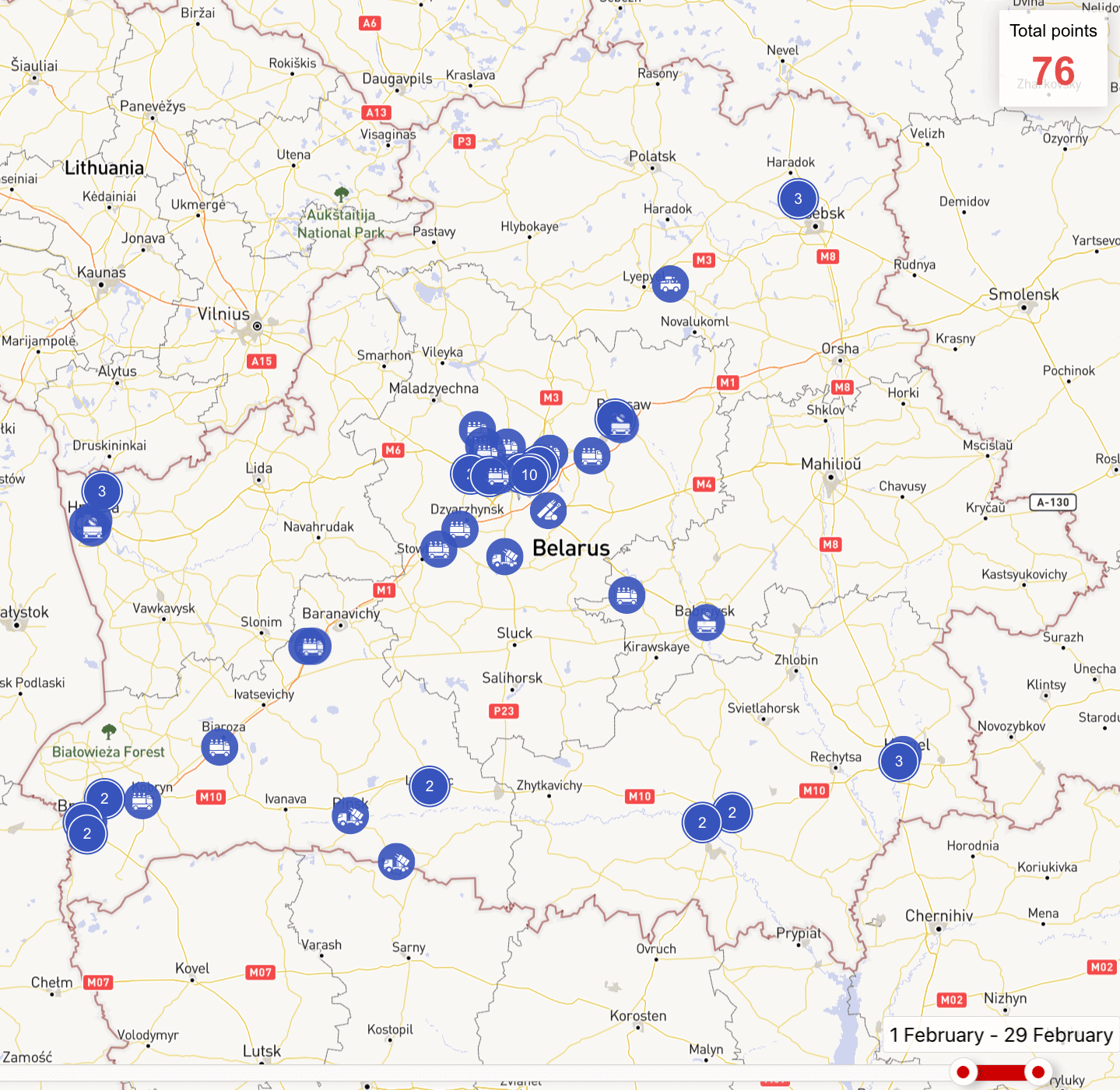
The intensity of movements of the Belarusian Armed Forces by rail increased compared to January. The movements of troops by rail were related to combat training activities, as well as the rotation of units of the Special Operations Forces deployed in the regions bordering Ukraine.
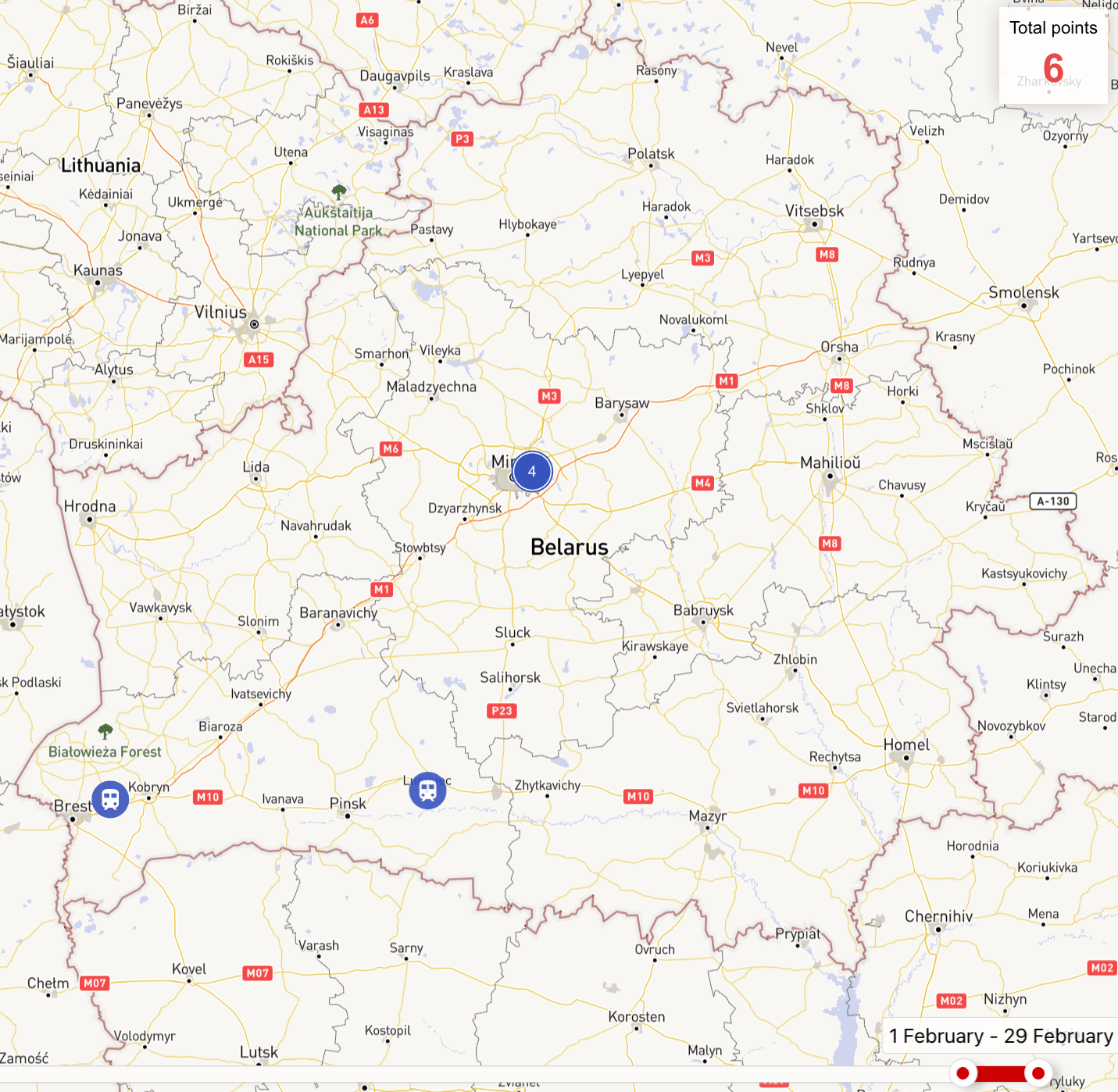
The intensity of flights of the Belarusian Air Force increased twofold compared to January. Lida, Baranavichy and Machulishchy airfields were mainly used for flights, while Asautsy and Luninets airfields were used less frequently. The increase in the intensity of flights was caused, among other things, by the counter-terrorist operation conducted in Lelchytsy district on February 15. During the flights, the entire helicopter and aircraft fleet of the Belarusian Air Force was involved.
During the month, flights of helicopters of the Belarusian Air Force in the area of the borders with Poland were recorded.
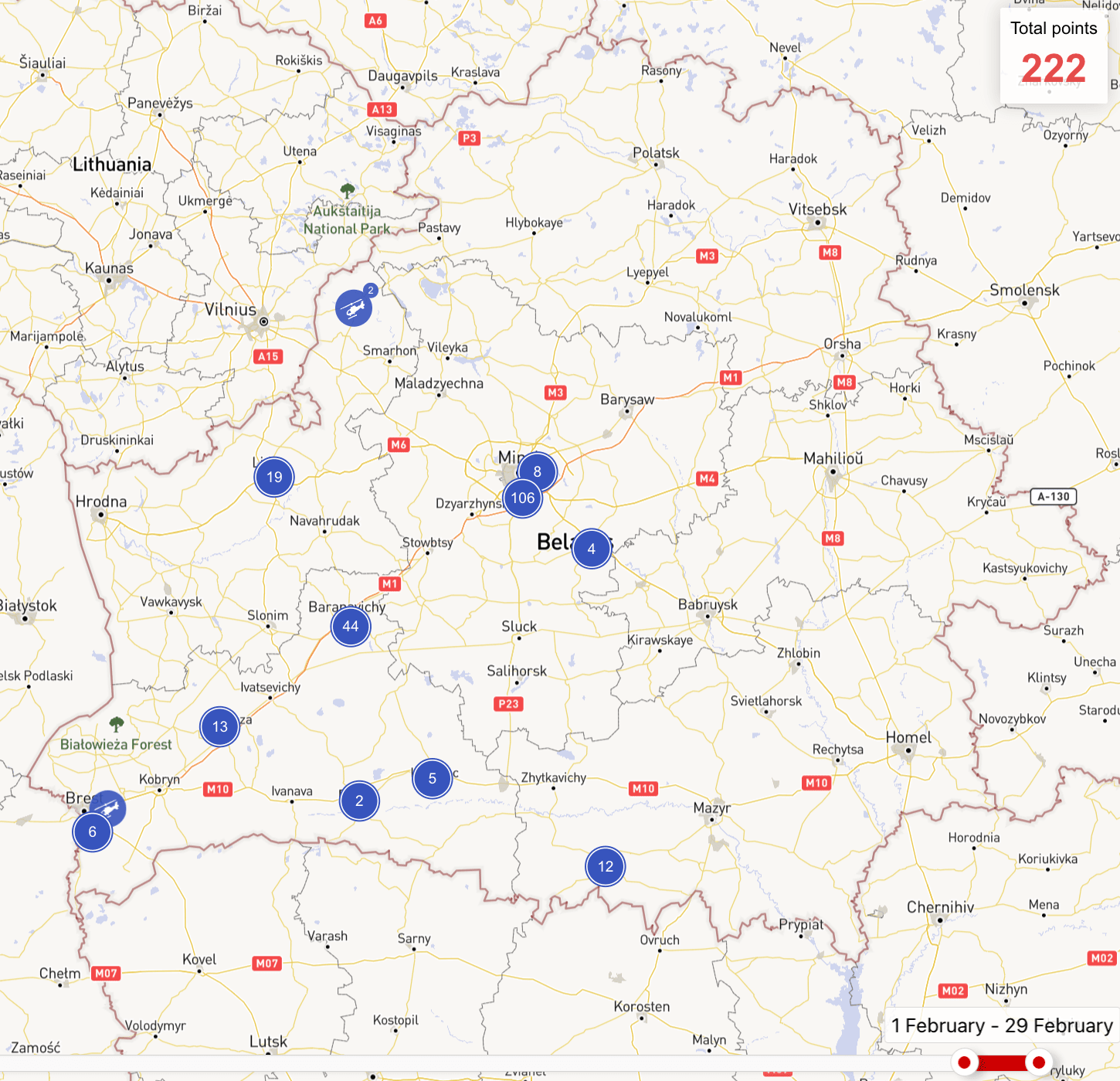
The presence of units of the Special Operations Forces of the Belarusian Armed Forces in the regions of Belarus bordering Ukraine continues. Despite the fact that it is officially declared that the military performs the tasks of guarding the border with Ukraine, at the same time, they guard Russian military facilities in Homiel region.
As of the end of February, the 357th Separate Paratrooper Battalion of the 103rd Airborne Brigade was deployed in the vicinity of Ziabrauka airfield (Homiel district). According to preliminary information, its rotation could have taken place on February 27-29. On average, the rotation of the units deployed in the regions of Belarus bordering Ukraine takes place every two months.
In turn, one of the detachments of the 5th Special Forces Brigade continues to be stationed in the vicinity of Mazyr. This is confirmed by the data on the movements of military equipment.
The total number of these units can be estimated at 400-500 people.
In addition to the units mentioned above, in the areas of Brest and Homiel regions bordering Ukraine, there are permanent deployment points of a number of units of the Belarusian Armed Forces, border guard units (Brest and Homiel border guard groups, Mazyr and Pinsk border guard detachments) and the Internal Troops (the main ones are in Homiel, Mazyr and Brest). It was reported that in 2023, more than seven thousand servicemen of the Internal Troops were engaged in guarding the state border.
In early February, the commander of the United Forces of the Ukrainian Armed Forces, Serhiy Nayev, said that the number of the Belarusian group in the areas bordering Ukraine was 1800 servicemen of the Special Operations Forces of the Belarusian Armed Forces (two battalions), as well as a tactical group of artillery and border guard units. It should be noted that statements by Ukrainian representatives about the size of the Belarusian Armed Forces group deployed in the regions bordering Ukraine were sometimes contradictory.
For example, on January 19, 2024, Serhiy Nayev said, “In addition to border guard units, about 1800 soldiers of the armed forces are kept along the border on the Belarusian side to reinforce the border.” It follows from this statement that there are 1800 servicemen of the Belarusian Armed Forces alone in the areas bordering Ukraine. Although we could conclude from the statement made in early February that there are 1800 servicemen not only of the Belarusian Armed Forces, but also of the Border Guard Service. The number of the Belarusian group (1800 people) was announced earlier as well.
Previously, information about the deployment of a tactical artillery group consisting of soldiers of the 51st Artillery Brigade and the 336th Rocket Artillery Brigade near the border with Ukraine was repeatedly reported. During the monitoring period, we have recorded movements of artillery units in the regions bordering Ukraine in June 2023. Therefore, we don’t have sufficient data to confirm or deny the presence of artillery units of the Belarusian Armed Forces near the border with Ukraine.
Currently, there are no grounds to claim that the size of the Belarusian Armed Forces group near the border with Ukraine may increase.
During the month, military commissariats conducted trainings with reserve officers assigned to the territorial troops, administrations of mobilization facilities, and others. It was also reported that trainings on military transportation duties, military registration and reservation of persons liable for military service were held.
No drills with the territorial defense and national home guard were reported in February. Most likely, we should expect such drills in March, as it was in 2023.
Other notable events include the following:
1) On February 7, representatives of executive committees and military commissariats of Homiel Region held a training on the organization of territorial defense in Dobrush. During the training, the mechanism of drafting soldiers from the reserve was practiced.
2) On February 7-8, a mobilization training of military commissariats on the topic “Management of mobilization of citizens and vehicles” was held in Minsk region.
3) On February 13-14, the military commissariats of Asipovichy and Klichau districts held a mobilization training, during which the evacuation of personnel and equipment was practiced.
4) On February 13-14, a command staff training with the territorial defense authorities of Minsk was held under the leadership of the head of the territorial defense directorate of the General Staff.
5) On February 20, representatives of executive committees of Mahiliou region took part in a training on the organization of territorial defense.
6) On February 20-21, a sudden inspection of the territorial defense management bodies was held in Miory district. As part of the inspection, persons liable for military service and national home guard units were trained.
7) From February 27 to March 1, a commission of the General Staff inspected the territorial defense authorities of Minsk.
In February, at least 7 court verdicts were reported in criminal cases against citizens who evaded conscription for active military service (Article 435 of the Criminal Code). This is not a final figure yet, as sentences are published in the public domain with a delay. This is three times less than the number of verdicts given in February 2023.

The analysis of the results of the spring-2023 conscription shows that the preparation of a personnel reserve for the formation of units of the Southern Operational Command has begun. There is also a clear tendency to increase the number of servicemen serving under contract in the Belarusian Armed Forces.
During the month, there were reports of training sessions with reservists in:
- the 147th Anti-Aircraft Missile Regiment (at least 10 reservists);
- the 111th Artillery Brigade (at least 11 reservists);
- the 56th Signal Regiment (at least 10 reservists);
- the 72nd joint training center (1, 2) (at least 20 reservists).
There was information that military commissariats of Minsk region sent reservists to military training sessions (at least 23 reservists). It was also reported about the selection of reservists for a military training session, which is to take place in the 8th Brigade of NBC protection. There were reports of training sessions with volunteers of the Chest special purpose detachment of the Internal Troops.
According to the clarified information, reservists from Hrodna region (at least 40 people) were also drafted for military training sessions in January.
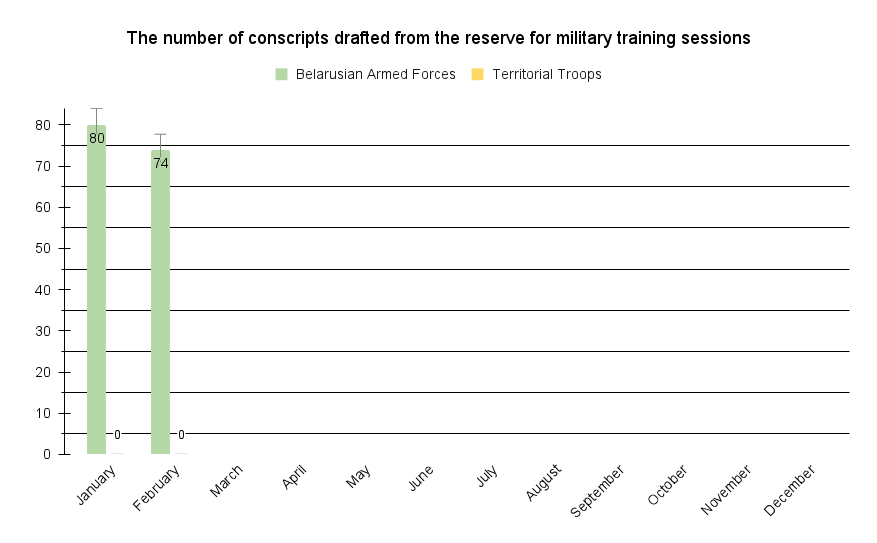
Thus, the total number of reservists drafted to military training sessions in February can be at least 74 people. We note that this is the minimal number of reservists who have undergone military training sessions. In reality, their number may be several times higher, since open sources publish only fragmentary data on conscription to military training sessions. However, as the experience of 2023 shows, the peak of conscription of reservists to military training sessions was from March to September.
The Ministry of Defense of Belarus hasn’t reported the number of conscripts to be drafted to military training sessions in 2024. A total of 9000 people were planned to be drafted to training sessions in 2023.
We shouldn’t expect that in 2024 the intensity of military training sessions will be lower. This is indicated by changes in the rules for the conduct of military training sessions, which make it possible to draft reservists more frequently.
Supplies of new military equipment and ammunition to the troops.
There were reports on the supplies of new military equipment to the Belarusian Armed Forces in February. For example, the troops received another batch of the ATsIP-6 automobile water tankers. The vehicle is equipped with a 6000-liter water tank and is mounted on a MAZ chassis. Equipping with such vehicles increases the maneuverability of rear units and enhances water delivery capabilities. It should be noted that attention has recently been paid to re-equipping material support units with modern means.
Plans on rearmament were also announced:
1) Artillery units of the Belarusian Armed Forces will soon receive new rockets for the BM-21 Grad MLRS. The new shells have a higher accuracy, and their declared range is up to 40 kilometers. Most likely, the ammunition will be produced in Belarus. However, no major supplies should be expected so far, as no large-scale production of this type of ammunition has been established yet.
2) Deputy Defense Minister for Armament Andrei Fedzin spoke in an interview about deliveries of new equipment to the Belarusian Armed Forces. According to the official, in 2024, the Belarusian Armed Forces will receive the Mi-35M helicopters, Tor-M2 SAM systems, T-72BM2 tanks, BTR-70MB armored personnel carriers, etc. It is also planned to take into service the modernized Buk-MB2 SAM system, Volat V-2 armored personnel carrier and Chekan UAV.
3) The first batch of 9K57 Uragan MLRS was sent for modernization. During the modernization, the engines and communications equipment will be replaced, the guns will be fitted with electronic tablets with software. The modernization will help to increase the range and cross-country capability of the MLRS and reduce the time required to strike the enemy with fire.
Based on the statements of Belarusian military officials, we can conclude that the Belarusian Armed Forces won’t receive a number of armaments from Russia in the near future, the delivery of which was announced earlier. These are the Su-30SM fighters, BTR-82A armored personnel carriers and the Iskander-M missile system. According to clarified information, the Belarusian Armed Forces received two divizion sets of the S-400 SAM system and two divizion sets of the Iskander-M missile system from Russia.
In addition, we can note that units of the Belarusian Armed Forces continued to manufacture anti-drone canopies. It was noted that these devices play an important role in increasing the protection of military equipment against UAVs. Another innovation that repair units have begun to implement is the production of weapon mock-ups. They are used as false targets and to identify the firing positions of a conditional enemy.
The production of anti-drone canopies and weapon mock-ups was based on the analysis of the experience of the war in Ukraine.
Training of military personnel
A military department was opened at Polatsk State University. Students are recruited in four military specialties: use of artillery reconnaissance units, use of electronic warfare units, use of engineer-sapper (engineering) units, and use of general military vehicle units. The department will provide training for reserve officers.
Activity of the military-industrial complex.
1) Tests of the modernized BMP-1KSh command staff vehicle equipped with modern digital radios were successfully conducted at the Asipovichski training ground. The modernization was carried out at the 619th base for storage, repair, modernization and utilization of communications equipment of the Belarusian Armed Forces.
2) Combat firing tests of the modernized 9A33-2B combat vehicle from the Osa SAM system have been completed. Modernization works have been carried out since 2017. During the modernization of the combat vehicle, 70% of the standard equipment was converted to digital format. The MAZ-6317 vehicle is used as the standard running gear of the 9A33-2B. It was noted that the modernization allowed it to significantly improve the combat and operational characteristics of the vehicle. No plans to supply the vehicles to the troops have been announced yet.
Development of military infrastructure.
1) According to open source, 25 canopies of various types were built on the territory of the 969th tank reserve base from 2017 to 2024. And all the equipment, which was previously stored in the open-air, was moved under the canopies. Similar works were recorded on the territory of other military equipment storage bases. The relocation of equipment from the open-air to canopies is carried out primarily to improve storage conditions. For many years, some of the equipment was in the open air, which had a negative impact on its condition (corrosion of metal, etc.). This ensures greater secrecy of storage, as the possibility of fixing changes in its quantity is almost completely excluded.
2) On February 8, the opening of the Makhro border outpost complex of the Pinsk Border Guard Detachment took place. The new outpost is located in Makhro village (Ivanava district, Brest region). It protects a section of the state border with Ukraine, which is more than 30 kilometers long. The guard line is equipped with the Voron fiber-optic alarm system with video surveillance, a control and trace line, an automated technical observation post, observation towers, and various engineering barriers. Preparations for the construction of the outpost infrastructure facilities began in early 2023.
Formation of new units.
A new special purpose detachment, Granit, was formed on the basis of the 1st Separate Special Militia Brigade of the Internal Troops. The main tasks of the unit include combating illegal armed groups and sabotage and reconnaissance groups, providing a forceful support to operatives during the arrest of dangerous criminals, and strengthening the protection of the state border.
On February 8, at a meeting of the board of the Internal Troops, Commander of the Internal Troops Mikalai Karpiankou said that a total of 10 special purpose detachments had been formed, and that in the near future it would be necessary to ensure the effective use of the “Special Forces of the Ministry of Internal Affairs.”
During the month, no new information about the deployment of TNWs in Belarus was published. We can only mention statements of Belarusian speakers about the deployment of TNWs as an accomplished fact. For example, on February 20, Lukashenka once again said that TNWs had been deployed in Belarus.
Currently, there is still no reliable data that would confirm the presence of TNWs on the territory of Belarus. Political statements about TNWs in Belarus made by Lukashenka, his officials and ‘experts’ can’t be trusted.
1) The Internal Service Statute of the Belarusian Armed Forces was amended. Now the document contains a norm that eliminates responsibility from a serviceman for harm caused to citizens as a result of the use of physical force, military equipment or weapons. Most likely, these amendments are an echo of the events of 2020, when the Belarusian Armed Forces were used to suppress protests.
2) On February 12, a decree on conscription for active military service was signed. The document envisages conscription for active military service (service in the reserve) of Belarusian citizens who meet the established criteria in February-May 2024. Such decrees are signed twice a year before each conscription for active military service.
3) On February 12, a resolution of the Security Council was signed approving the drafts of the National Security Concept and the Military Doctrine of Belarus. According to the resolution, the Ministry of Defense of Belarus should finalize the draft Military Doctrine taking into account the comments of the Security Council members. In the future, both documents will be submitted to the All-Belarusian People’s Assembly for approval and will be approved by March 25, 2024.
4) On February 28, the draft law “On amendments to laws on ensuring national security” was adopted in the second reading. Some of the main innovations of the draft law are: toughening of responsibility for evasion of military registration and conscription, the possibility of informing citizens about the need to appear at the military commissariats via SMS, etc.
1) On February 17, it became known that the Deputy Minister of Defense and Armed Forces Logistics of Iran (MODAFL) for International Relations Seyed Ghalandari visited Minsk. During the meeting with the head of the Department of International Military Cooperation, the parties discussed the issues of current interaction and negotiations within the framework of the upcoming events of the Shanghai Cooperation Organization.
2) On February 20, foreign military attachés visited the facilities of the border guard service on the border with Lithuania. The representatives of the military agencies got acquainted with the specifics of service at the section of the Smarhon Border Guard Group and the Cynological Center.
On February 15, a “counter-terrorist operation” regime was introduced in Lelchytsy (located 10 km from the border with Ukraine). The local authorities said that drills were held on the territory of Lelchytsy district. However, when the counter-terrorist operation regime was introduced, the local authorities can’t know what is going on even according to the law – everything that happens is controlled by law enforcement agencies. At the same time, in the morning of February 15, helicopters arrived in Lelchytsy from Minsk, bringing servicemen of the Internal Troops and the Belarusian Armed Forces. Judging by the actions of the enforcers and public communication, it didn’t look like classic drills and it was most likely an emergency situation.
On February 16, Lukashenka said that a sabotage and reconnaissance group was detained in Lelchytsy district. The enforcers detained two citizens of Ukraine and one citizen of Belarus. According to official information, the sabotage and reconnaissance group was supposed to allegedly deliver explosive devices to commit terrorist acts in Russia and Belarus on the instructions of the Ukrainian security services. According to the media, the detainees were under investigation in Ukraine for drug smuggling. Everything indicates another informational provocation by the security agencies of Lukashenka’s regime ahead of the elections in Belarus.
The situation with the group of the Russian Armed Forces in Belarus didn’t change in February compared to previous months. There is no reason to believe that servicemen of the Russian Armed Forces will start arriving in Belarus in the near future. At the same time, it is possible that if a new wave of mobilization is announced in Russia, the infrastructure of the Belarusian Armed Forces will again be used to train the mobilized.
Russian military continue to be stationed at Mazyr (Bokau) and Ziabrauka airfields. There is no information about the changes in the number of equipment located at Mazyr (Bokau) airfield at our disposal. At the same time, satellite images dated early February confirm the presence of the Russian military at Ziabrauka airfield. Movements of military equipment and servicemen of the Russian Armed Forces in Mazyr were also recorded during the month.
So far, it has not been publicly reported in what status the Russian military are present at the airfields and what exactly they are doing there. It’s known that units of the 1530th Anti-Aircraft Missile Regiment of the Eastern Military District of the Russian Armed Forces (military unit 31458) are stationed at Mazyr (Bokau) airfield. The regiment’s units were redeployed to Belarus in early February 2022.
Thus, as of March 1, 2024, the number of Russian military personnel stationed in Belarus didn’t change and can be estimated at about 2000 people. Of these:
- at Baranavichy, Mazyr (Bokau) and Ziabrauka airfields – 500-600 people;
- at the Baranavichy radar station and the 43rd Vileika communication center – up to 1450 people.
The intensity of movements of military equipment on public roads has remained almost the same as in January. Only occasional movements of equipment of the Russian Armed Forces have been recorded in the vicinity of Mazyr, Homiel, and Baranavichy, where the Russian military are stationed (for more details, see paragraph 2.1 of the review). We can also note that fuel trucks of the Russian Armed Forces were spotted in Baranavichy near the 2657 fuel and lubricants base of the Belarusian Armed Forces. Previously, it was repeatedly reported that the Russian military had been receiving fuel from the material support units of the Belarusian Armed Forces.
More details on the movements of military equipment are available on the map.
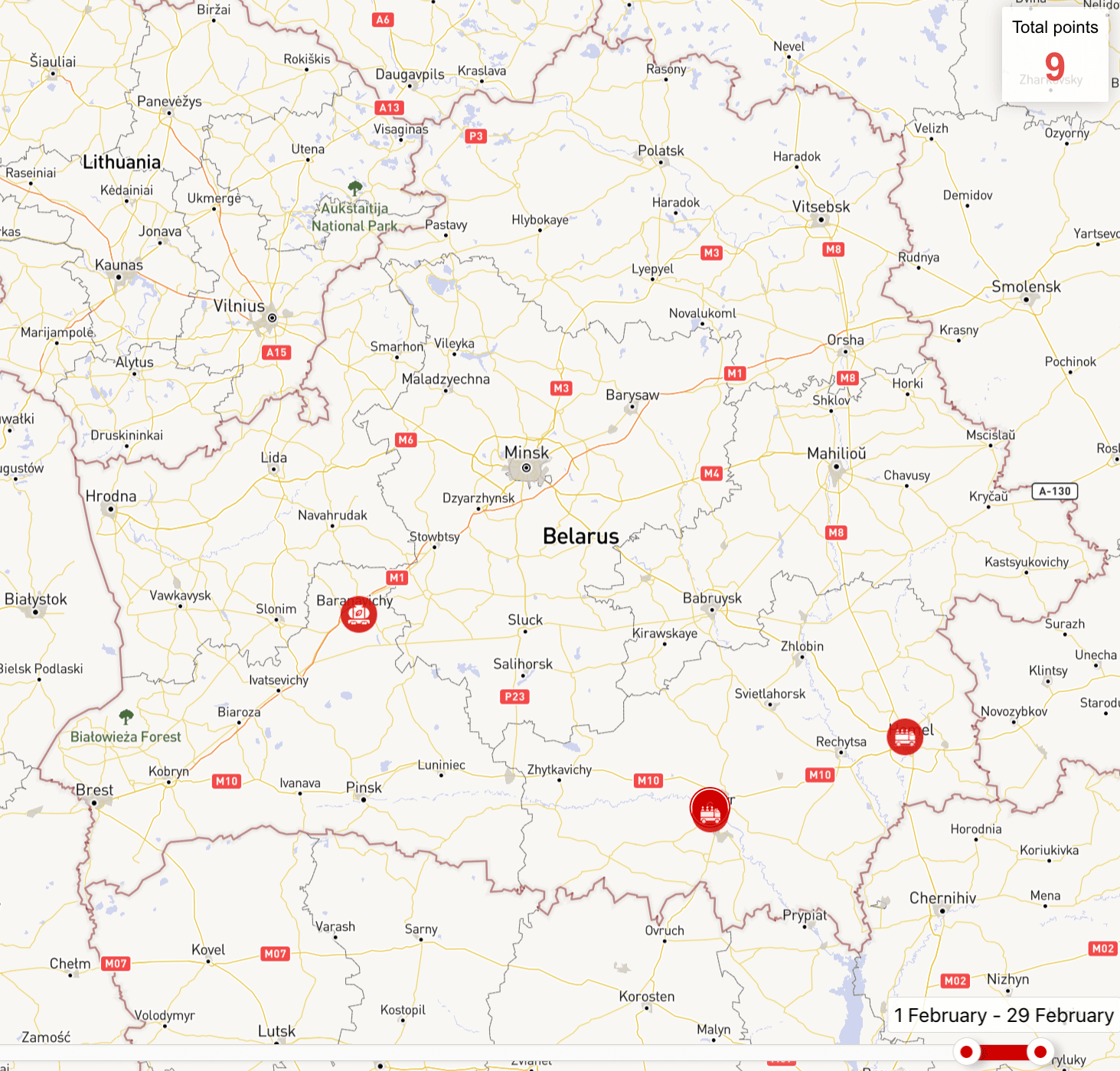
No movements of the Russian Armed Forces by rail were recorded in February.
Aviation activity of the Russian Aerospace Forces slightly increased in February compared to January.
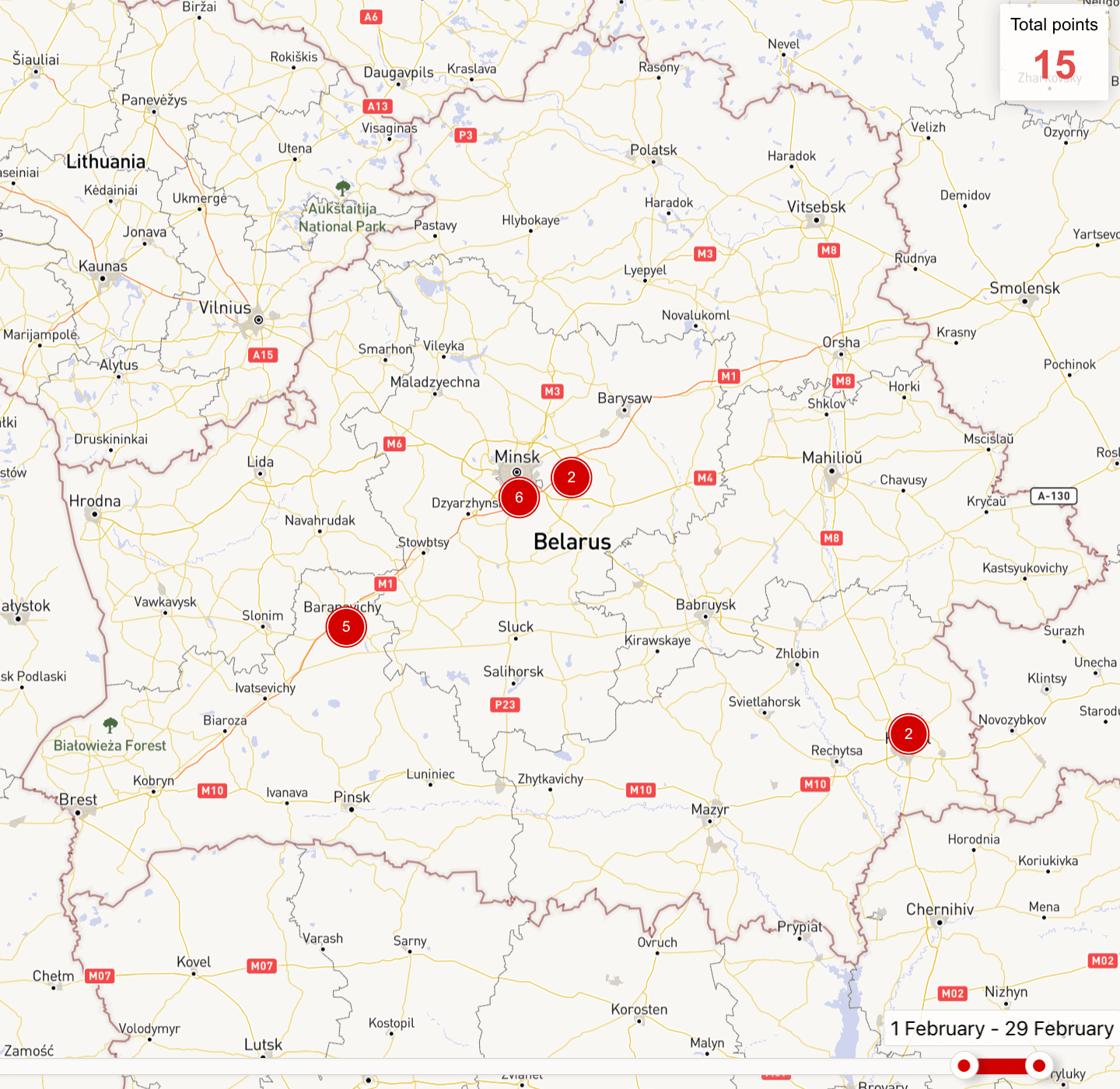
Military transport aircraft of the Russian Aerospace Forces kept arriving at the airfields of the Belarusian Armed Forces and civilian airports:
- Minsk National Airport: passenger – 1 Tu-134 (note: most likely, the aircraft arrived for maintenance at Minsk Civil Aviation Plant No.407), 1 Tu-134 and 1 Tu-154 (note: the aircraft brought a military delegation headed by Russian Deputy Defense Minister Aleksei Kuzmenkov to Belarus to participate in the celebration of the 20th anniversary of the Belarusian Armed Forces Armament Day).
- Homiel airport: transport – 1 An-12.
We can note that the trend towards a reduction of the number of arrivals of passenger and military transport aircraft to Belarus remains.
Also, on February 7, 9, 14, and 21, flights of fighters of the Russian Aerospace Forces were recorded at Baranavichy airfield.
We received no information on the changes in the number of the Russian Aerospace Forces aviation group during the month. As of March 1, the following aircraft of the Russian Aerospace Forces are permanently stationed on the territory of Belarus:
- at Lida airfield – one Su-25 attack aircraft;
- at Baranavichy airfield – two Su-24M/MR aircraft and at least one Su-30SM fighter.
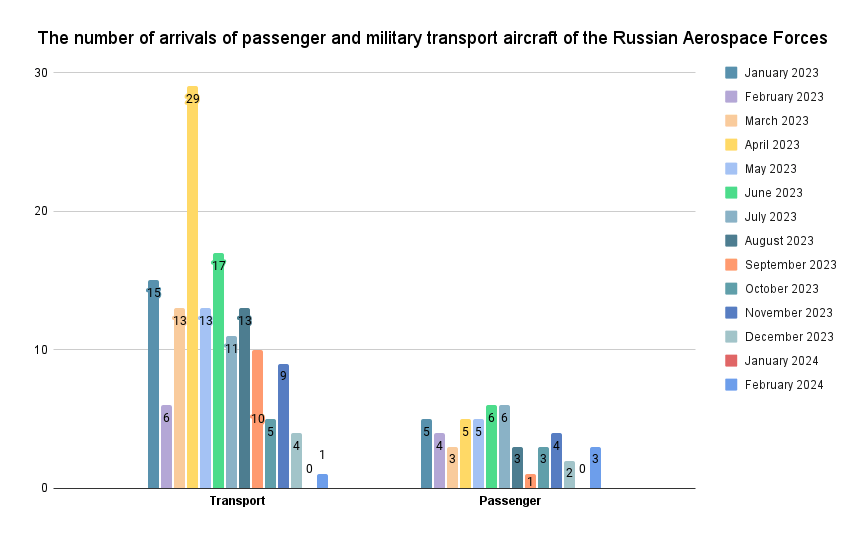
One An-12 military transport aircraft of the Russian Aerospace Forces arrived at Homiel airport in February. Prior to that, the aircraft arrived at the airport in December 2023. The dynamics of arrivals of the Russian Aerospace Forces aircraft at Homiel airport can be seen in the chart below.
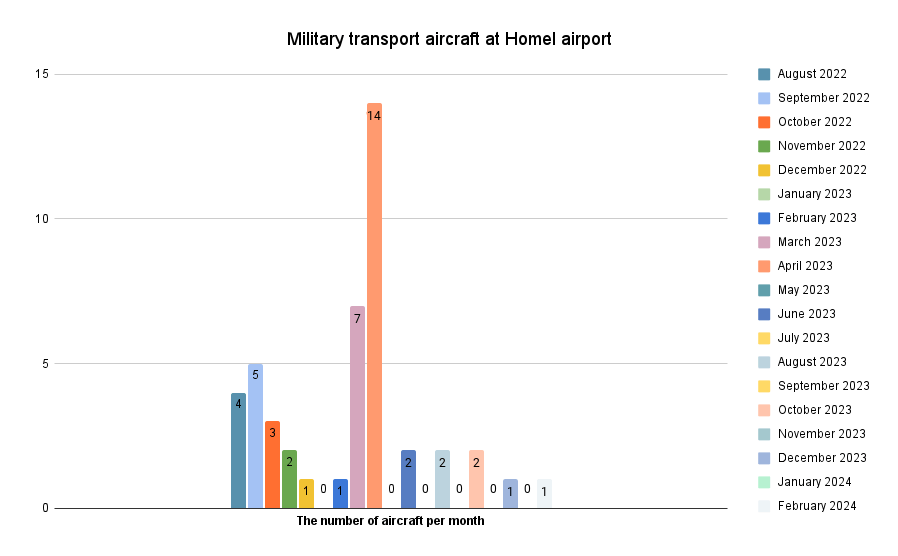
The situation with the mercenaries in Belarus has slightly changed compared to previous months.
The main activities of the mercenaries in Belarus haven’t changed. They continued to conduct systematic trainings with servicemen of the Internal Troops. Deeper cooperation with the Belarusian Armed Forces was also reported (for more details, see paragraph 1.1 of the review).
At the same time, there is every reason to believe that at least some of the mercenaries of PMC Wagner may have left Belarus for Russia. The probable reason for departure could have been participation in the training of volunteer formations of Rosgvardiya before sending them to the front. The exact number of the mercenaries who have left Belarus is unknown.
Possible reasons why the mercenaries could have left Belarus could be the following:
1) the end of agreements on the training of the Belarusian enforcers and the termination of mercenaries’ ‘mission’ in Belarus;
2) temporary break in the training of the enforcers (with subsequent resumption/continuation);
3) rotation of ‘instructors’ (new ones will arrive instead of those who left and will continue to train the enforcers).
Lukashenka’s statement about the mercenaries made on February 20 was also illustrative. He explicitly hinted that the mercenaries of PMC Wagner had completed the work on sharing combat experience. “Our officers know everything else at the same level, they graduated from the same academies,” he said. We can state that the enforcers were given a clear signal to stop with the praise of the mercenaries. The consequences of this statement are already evident. For example, the press service of the Internal Troops, which previously published photo and video reports from trainings with Wagner mercenaries very actively, has stopped mentioning the name of the mercenaries in its information resources since February 9.
We can only guess the reasons for Lukashenka’s statements about the mercenaries. As a hypothesis, we may assume that Lukashenka could have become concerned about the strengthening of the influence of the mercenaries and their establishment of horizontal ties with the Belarusian security forces.
Thus, the number of the mercenaries in Belarus could have decreased and could be estimated at hundreds of people.

No active movements of PMC Wagner mercenaries on the territory of Belarus have been recorded. At the same time, according to satellite images, as of mid-January 2024, tents and mercenaries’ vehicles are still stationed at the Wagner camp in Tsel village, Asipovichy district.
Speaking of the prospects for the presence of the mercenaries in Belarus, we can note that the forecasts described in the review for October remain valid, but require some clarification. The prospect of integrating the mercenaries into the security forces looks ambiguous after Lukashenka’s statements. At the same time, there should be no illusions that the mercenaries would be completely withdrawn from Belarus.
- The general conclusion on the situation with the Belarusian Armed Forces mentioned in the review for January 2024 remains valid.
- The general conclusion about the status of the Russian Armed Forces on the territory of Belarus didn’t change. The deployed units of the Russian troops don’t pose a threat to Ukraine and other countries bordering Belarus. The number of the Russian troops in Belarus doesn’t allow us to speak about preparations for a second invasion of Ukraine from the territory of Belarus.
At the moment, the number of the Russian contingent in Belarus may increase, for example, if a new wave of mobilization in Russia is announced, or under the influence of other unpredictable events. It is possible that a new mobilization will be announced in Russia after the presidential election.
An additional indicator of low activity of the Russian Armed Forces in Belarus is a small number of arrivals of military transport aircraft of the Russian Aerospace Forces in the past few months. This confirms the small size of the Russian contingent deployed in Belarus.
One of the factors that could potentially influence the increase of the Russian military presence in Belarus is the possibility of establishing combat training centers for joint training of troops. After the final ratification of the agreement between Belarus and Russia in December 2023, there have been no public announcements about the creation of new combat training centers in Belarus so far. The creation of new combat training centers will allow Russia to permanently deploy its military equipment in Belarus. So far, we don’t see Russia’s efforts to increase its military presence in Belarus through the system of combat training centers. We can expect that as long as active combat operations in Ukraine continue, Russia won’t have the resources to deploy its additional troops.
Joint major drills on the territory of Belarus announced for 2025 could be used by Russia to increase its military presence in the country.
In general, the level of activity of the Russian Armed Forces in Belarus in February could be described as very low.
- All the conclusions regarding the prospects for the deployment of PMC Wagner mercenaries in Belarus given in the review for October 2023 remain valid. A small number of mercenaries are still stationed in Belarus, who serve as instructors for Belarusian military structures. At the same time, there are signs that Lukashenka is concerned about a greater integration of the mercenaries into the security forces.
At the moment, there are no signs of a complete shutdown of mercenaries’ activities in Belarus.
In general, the level of activity of PMC Wagner in Belarus in February could be described as low.
